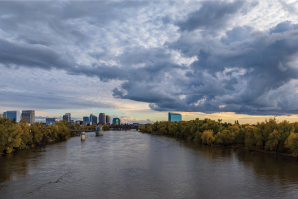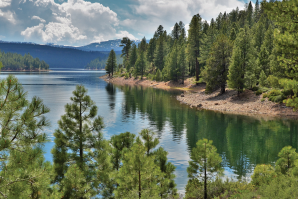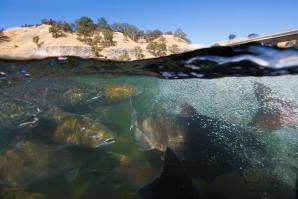Moshiur Rahman doesn’t know much about what’s going on with federal funding for the facility he works at, the UC Davis Fish Conservation and Culture Laboratory near Byron.
What Rahman, an assistant project scientist, knows is the value of the work that his facility does researching and breeding smelt such as the endangered Delta smelt. While the population of this fish has been largely depleted, it can help feed other parts of the Delta ecosystem and prevent algae blooms. Rahman even knows what he’d say to people trying to politicize smelt: “You have to save this species.”
This might be in doubt, with the San Francisco Chronicle reporting on Feb. 6 that the federal government was looking to not renew funding for the lab after its current round expires on Friday. While sources close to UC Davis are confident of a new contract being signed with the U.S. Bureau of Reclamation, that hadn’t happened as of press time. People like Rahman warn about what could happen next.
“If you are not funding us, then we have to stop the research and then these species, I’m pretty sure, will be extinct within (a) few years, like five or six years,” Rahman says. “And then other species will be impacted. And finally, the total ecosystem will be broken down, right?”
How we got here
Times used to be different for smelt, according to people like Nann Fangue, a professor and chair of the Department of Wildlife, Fish & Conservation Biology at UC Davis. “At one time, they were the most numerous fish in the estuary, and they really were a key part of the food web,” Fangue says. “But a lot of that has changed now.”
When Peter Moyle, a distinguished professor emeritus at UC Davis began working on smelt in the late 1970s, they were quite abundant, he recalls. “Now, they’re pretty much gone,” Moyle says.
FCCL now works to breed Delta smelt. The lab’s website says this effort dates to 1992, when the fish “were initially proposed for listing after finding concerning numbers of Delta smelt in the wild.”
For decades, this work was carried out quietly by people like Tomas Mosquera, who had a brief stay at FCCL while doing post-doctorate work. In the few months he spent at FCCL, Mosquera helped set up a Y-maze experiment. This entailed building a fish tank shaped like the letter Y, allowing fish to choose two paths of different conditions, which could show the turbidity Delta smelt might prefer.
The UC Davis Fish Conservation and Culture Laboratory near Byron,
California breeds Delta smelt. (Photo by Graham Womack)

“What I liked about my job there is that it was pure research, without commercial interest, just with the purpose of learning more about this fish species in order to protect it,” said Mosquera, who answered questions via email. “Everyone working there seemed to be in tune and created a good environment during my short stay.”
Among conservatives, though, smelt have become a lightning rod for criticism. At a round table in Pacific Palisades on Jan. 24, President Donald Trump gave a long answer about how Central Valley farmland wasn’t getting water before he digressed into discussing smelt.
“They talk about the Delta smelt, which is a fish that’s this big,” Trump said, holding out his thumb and index finger, in remarks captured by Forbes Breaking News. He added, “But it is, it is really not, doesn’t have to be protected because it’s in other areas. It’s in numerous other areas. So it doesn’t have to be protected. The people of California have to be protected.”
Fangue dismisses the notion that Trump is to blame for the FCCL facility facing the threat of losing its funding, suggesting instead that it’s just normal contract negotiations.
“It’s never easy,” Fangue says. “Everything’s always late. These contracts in the past on this five-year cycle have always been signed a month or two late. So that’s like normal. I think this time is just more uncertain because of the politics.”
UC Davis spokesperson Bill Kisliuk declined to speak on the record for this article but provided a written statement saying that FCCL was working closely with the Bureau of Reclamation “and hopes to see funding extended past Feb. 28.”
Mary Knecht, chief of communications for the Bureau of Reclamation’s California-Great Basin region, didn’t immediately respond to a request for comment on Feb. 20.
What happens next
The loss of federal funding wouldn’t mean an immediate end for FCCL’s work. The Chronicle reported that 11 of the facility’s 17 employees could be laid off, suggesting that other funding sources exist for staff who would stay on.
Rahman, who primarily researches long-fin smelt, is among those who could remain in the near term. Rahman says he has funding for one project involving Delta smelt through September 2026 and also has a contract for his work with long-fin smelt. But his position as an immigrant from Bangladesh on a J1 visa is somewhat tenuous. “Next March, 1 March, my project had to be renewed,” Rahman says. “Otherwise, I cannot stay here.”
Fangue says UC Davis would do its best to piece together some kind of continuity plan. “The university certainly does not want to lose these beautiful endangered fish,” Fangue says. “And neither does the bureau.”
Lost in all the discussion of whether FCCL’s federal funding will remain is what might happen if the lab ultimately succeeds in bolstering the population in the wild of Delta smelt. “I think it would be viewed as a conservation success story,” Fangue says. “I mean, if you can conserve a species in this crazy place with all the water politics that we have to deal with and just the water wars, that’s a very positive, I think, conservation story broadly.”
–
Subscribe to the Comstock’s newsletter today.
Recommended For You

The Delta in Decline
Wildlife and businesses in the Sacramento-San Joaquin Delta are suffering from lack of fresh water
The life cycle of a salmon, so the story goes, is a heroic journey. The fish emerge from fertilized eggs in a river bed, swim to the ocean where they spend most of their lives and return to give birth in the exact place where they were born.

Is Sacramento Ready for the Big One?
Levees and dams are being repaired and expanded to prepare for a future flood
Climate change is increasing the strength of Sacramento’s winter storms. Higher temperatures allow atmospheric rivers to carry more water, research shows. Climate change is also jacking up other flood risks, such as sea rise and snowmelt. All this is raising the chances of catastrophic flooding in Sacramento.

What’s on the Horizon for California’s Public Lands?
With less funding in the current budget, the management of public lands is likely to change substantially, and this may have massive and unforeseen consequences for Californians.

‘No Way, Not Possible’
California has a plan for new water rules. Will it save salmon from extinction?
CalMatters: The Newsom administration is refining a contentious set of proposed rules, years in the making, that would reshape how farms and cities draw water from the Central Valley’s Delta and its rivers. Backed by more than $1 billion in state funds, the rules, if adopted, would require water users to help restore rivers and rebuild depleted Chinook salmon runs.



